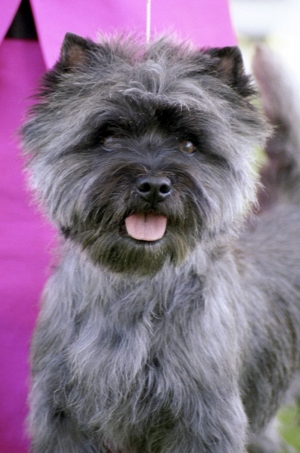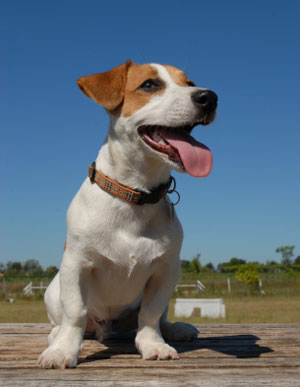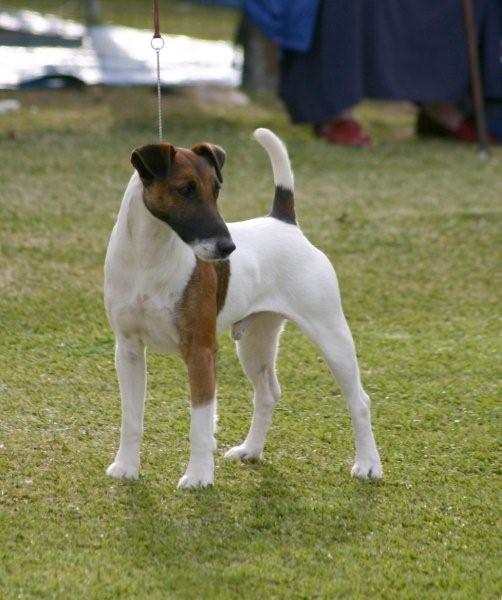
Personality: The Cairn Terrier is an alert, active, hardy, assertive and outgoing little pooch. It is keen to please and will generally bond with one particular person in a household.
Suitable for: The breed is suitable for most people, but keep in mind that given its boundless energy, a young puppy may not be suitable for an elderly person.
Favourite activities: Cairn Terriers love nothing more than curling up on warm laps, hunting, swimming, digging, playing and being with their families.
Watchdog qualities: For a small dog, this breed has a rather loud bark and will do so selectively if trained appropriately, making it a good watchdog.
Hereditary diseases: The breed is fairly healthy and free of major genetic problems, but it has been known to suffer from undescended testicles and slipping patellas. Another potential problem is liver shunt.
Toto from The Wizard of Oz is probably the best-remembered Cairn Terrier of today’s popular culture. Rest assured, Dorothy’s fearless and mischievous on-screen sidekick is just as memorable off-screen.
Instead of encounters with lions, tigers and bears, its more of a case of close encounters with foxes, badgers, otters and weasels at the turn of the 20th century.
These feisty Terriers were originally bred to hunt in the rocky outcrops of the Scottish highlands and western islands, particularly the Isle of Skye of Scotland. Many believe that the Cairn Terrier is the oldest purebred British dog, even older than the Scottish Terrier. At the turn of the century, the Cairn was also known as the Short-Haired or Prick-Eared Skye Terrier.
The Cairn Terrier has been in Australia since approximately 1930, with the Cairn Terrier Clubs in New South Wales and Victoria boasting relatively established histories. Dogs Life speaks to the Cairn Terrier Club of NSW’s secretary, Robert Bartram, about the history of the club.
Established in the mid-1960s, the club has been run out of Sydney until recently, but the lack of metropolitan members has forced its relocation to Queanbeyan in the southern region of NSW. Club members are encouraging city folk with Cairn Terriers to join the organisation to get the numbers up again.
Bartram recommends the breed to most people, but offers words of caution if your energy levels are low or if you are elderly. A young energetic puppy might not be suitable for an elderly person, where an older and more settled dog may fit the bill, he says. In general, though, Cairn Terriers are suitable for those who are willing to spend time with them, exercise them regularly and put a little effort into maintaining their coat.
Bartram recommends the breed to families with young children, as he believes the active and outgoing nature of the Cairn Terrier lends itself ideally to a family situation. Please remember that young children will need to be supervised when playing with any dog, and the Cairn is no exception.
Enjoys human companionship
Jill Saulbrey, former president of the Victorian Cairn Terrier Club, established as early as 1945, also emphasises that the Cairn is very adaptable, but definitely needs companionship and company. The Cairn will generally get along with most people and family members in the household, but will bond closely with one particular person.
Bartram points out to Dogs Life that most Terriers have a mind of their own. He says they are generally obedient and do well at obedience trials, but if you want a dog that will obey every command at your will, the Cairn may not your ideal choice.
Like Bartram, many Cairn enthusiasts are attracted to the rugged and natural look of the breed, its size and, of course, its active, outgoing nature. Taking into account the Cairns hardy and innate digging qualities, a secure backyard is imperative, or you run the risk of your dog wandering off and, due the breeds impulsive nature, being hit by a car.
The Cairn is an active dog, and though a good-sized backyard may be of a sufficient size to keep your dog occupied, it is always advisable to spend quality time walking and playing. This will keep your dog from becoming bored and destructive, keep both of you fit and strengthen those human-canine bonds at the same time.
Caution for liver disease
Although the Cairn is relatively free of major genetic diseases, Bartram informs us of several conditions prospective owners should look out for in the breed. There have been occasional cases of undescended testicles and slipping patellas. Several liver-shunt cases have been recorded, which can be lethal if not detected early and treated.
According to Saulbrey, a very small percentage of Cairns develop liver shunt, but a simple and inexpensive test can be done before the puppy leaves for its new home. This is important to ensure that the dogs liver is functioning properly, and many conscientious breeders are now starting to test for liver disease in their stock to ensure the future longevity and health of the breed.
Bartram stresses that the test is a small price to pay for peace of mind and an important factor to think about before purchasing your dog.
Coat care
Grooming the Cairn need not be a very time-consuming activity. If your dog has a coat of the correct texture, grooming should be fairly easy.
Because it is a double-coated breed, Bartram recommends brushing the coat and combing through once or twice a week to prevent it knotting and to keep it healthy. The breed sheds once or twice a year, and if youve been maintaining the brushing and combing, enough coat will have been removed to keep it tidy, but it may be necessary to have the dog stripped.
Saulbrey suggests a weekly groom and, at the same time, any dead hairs should be removed by plucking with finger and thumb. For those of you wanting to outsource this, there are grooming parlours that will clip and hand-strip the coat, so it doesn’t lose its colour and texture.
Bartram advises owners to learn to hand-strip the coat themselves. New owners should talk to their breeder for advice. The NSW club has coat-care days in Sydney a couple of times a year.
If you think you’d like a Cairn Terrier but would like an adult dog, the Victorian Club has sales officers who also help re-home older dogs. Saulbrey tells Dogs Life that the Cairn can be successfully re-homed, as its very adaptable. The club also has a rescue service.
Grooming: 2 ticks
Exercise: 2 ticks
Size: Small
Lifespan: 12-15 years
Cairn Terrier Club of New South Wales
Secretary: Robert Bartram (02) 6297 5028
Cairn Terrier Club of Victoria
President: Ross Ward (03) 5629 9311

Jack Russell dogs are full of energy, are fun-loving and are suitable for dog obedience games like agility.
Personality: The JRT is lively, enthusiastic, fun loving and eager to please. They will thrive if exercised daily and included as part of the family.
Suitable for: Active people who enjoy spending time with, exercising and training their dogs. The JRT is a great family companion but is not suitable for children under five. The breed is great for older children as its always on the go.
Favourite activities: Running, playing fetch, agility, obedience, racing and hunting mice in the backyard. They love to play and their little legs will keep up with the best of you!
Watchdog qualities: Even though they’re a friendly breed, they are a good watchdog and will bark at unfamiliar sounds or people entering your property.
Backyard requirements: A secure fence is a requirement, as this breed tends to roam. If they get bored they will dig and become destructive. Provide plenty of toys and a safe digging area, such as
a sandpit.
The Jack Russell Terrier, a lovable and eager-to-please breed, takes its name from the Reverend John (Jack) Russell (1795-1883), a founding member of England’s Kennel Club in 1873. Reverend Russell, otherwise known as The Sporting Parson, was also a passionate fox hunter and it was this interest in fox hunting that lead to the breeding of the Jack Russell Terrier, in Devonshire, England, in the 1800s. With balanced proportions, intelligence and the ability to manoeuvre underground, the JRT became the perfect fox hunter, but nowadays he is also a wonderful companion and family pet.
Cheryl Burge, from Stoneybrook Kennels in Tamworth, NSW, has owned Jack Russells for the past 11 years and has been breeding and showing dogs for the past 35 years. Cheryl says, Jack Russells make great family pets. They love to play with children and are easy to train to play ball and fetch. This breed loves being part of a family, though their assertive and demanding nature makes them unsuitable for children under the age of five. They can also become bored quickly and therefore need an outlet for their considerable energy and intelligence. They’re good for people who enjoy walking and I have sold puppies to people who go jogging, as their little legs can run all day, says Cheryl.
However, JRTs can get enough exercise playing with the family in the backyard. I do recommend a daily walk, if you live in a flat, but if you have a big backyard or children, they get enough exercise playing, says Cheryl. The breed enjoys burning energy through ball games and can keep up with the most active family. If left alone in the backyard and not included with the family, as with most breeds, they will become mischievous and destructive.
This alert and ready attitude means the breed is always on the go. They are a smart little dog and easy to train. There are quite a few Jacks that do obedience and agility, says Cheryl. JRTs are also intelligent and willing to please, says Cheryl. They do try to please their owners and enjoy training for food rewards.
The JRT is an excellent hunting dog, still possessing a natural hunting instinct; therefore owners must be aware that the breed may also roam. A secure fenced yard must be provided, along with plenty of attention and exercise. Even though sometimes, it seems, the breed forgets about its ancestry. Our old dog Sandy used to play with the foxes in the paddock instead of chasing them away, laughs Cheryl.
The JRT also loves being with people and will protect the house if it hears an unfamiliar sound. Jack Russells make good watchdogs. They will run to the door if someone knocks or if they hear a strange noise, although they are more than likely to lick and play should the person be invited inside, says Cheryl.
Cheryl loves the JRT and says she has many funny stories she could tell. We have a dog called Stoneybrook Brite Lizzy who loves to sing along when my daughter plays the mouth organ. Also, when we are at the field days, Lizzy gets so excited about chasing the fox tail, she runs to the starting boxes by herself, puts herself in and crouches down ready to race, she laughs.
Jill Clinch, from Bluepanda Kennels in Springwood, NSW, also has plenty of amusing stories to tell about JRTs. You must remember this breed is known for their hunting ability.
My oldest female, Login, is very much that way; in fact, I have found the females are more so than the males. I can remember getting up one morning to find a dead rat on the lounge and there she was sitting next to it with a big smile saying, Look what I caught for you, Mum, laughs Jill. Another time, when Login had a litter of six-week-old puppies, she was always looking for a way out of the yard to go hunting (that’s why you need very secure fencing to own a Jack Russell). We back onto brush land and a valley, and the yard next door had, at that time, knee-high grass. I called and called for Login. Imagine my horror when I realised what had happened! Suddenly I heard the grass moving and there she was running through the grass followed by her puppies. Their little faces said it all: We’ve been hunting and, boy, was that fun. What could I do but be glad they were all back home safely, says Jill.
Jill has been breeding Jack Russell Terriers for seven years and has also been breeding Old English Sheepdogs for 28 years. She says the JRT is best suited to a person who is willing to give them plenty of time with exercise and training.
JRTs are a pleasure to live with as long as they receive training from day one. They can be hard to train if you do not show them who is boss. You must remember they are terriers. We have a number of them that are doing well in agility and enjoy it a lot, says Jill.
Even though the JRT is only 25cm high, what it lacks in height it makes up for in attitude, often forgetting its a small breed. Its size, stature and alertness suggest strength and endurance to function as a working terrier. It also has a harsh, waterproof coat that was perfect for its ancestors job of getting down and dirty in the foxholes. The coat is not hard to look after and grooming the breed is fairly low maintenance. There are three different types of JRT coats: smooth, broken and rough.
The smooths and brokens need a brush once a week to rid the coat of loose and dead hair.
The roughs, depending on how tidy you want them, need their coat stripped or trimmed on a monthly basis and this also depends on the coat thickness.
The hair on the tail will also need a trim and a weekly nail trim may also be required, says Jill.
The JRT coats can be white, white with black or tan markings, or a combination of all three, known as a tri-colour. Puppies cost from $400 each and must be wormed, microchipped and vaccinated.
If you purchase a puppy from a registered breeder they must supply the papers for the puppy, as all puppies must be registered with the Royal NSW Canine Council, even pet puppies, adds Cheryl.
Jill says the Jack Russell Terrier is a good family dog. I don’t recommend the breed for young children but for older children its ideal because JRTs are always on the go.
Daily: Fresh water and a balanced diet designed for small active dogs is essential. Daily exercise is a must, and leash-free running is ideal as long as its in a fully fenced, safe area.
Weekly: Regular brushing of all coat types (smooth, broken or rough) is a must. The rough-coated JRT, which has a thick shaggy coat with eyebrows and a beard, requires the most grooming.
Monthly: The rough-coated JRT will need its coat stripped or trimmed, and the hair on its tail trimmed. Nails may also need to be trimmed. Bath when necessary and monthly heartworming.
Regular: Gastrointestinal worming every three months. Annual vaccinations.
Hereditary diseases: Jack Russell Terriers, like many small breeds, can be afflicted with luxating patellas, but this condition is rare.
More information
Websites
www.akc.org/breeds/recbreeds/jrt.cfm
American Kennel Club website lots of interesting information on the breed
www.ankc.aust.com/jackruss.html
Australian National Kennel Council many facts about the Jack Russell Terrier
www.barkbytes.com/breedbk/jckrt.htm
Features breed books, products and information about the breed

Care and exercise
Coat care of the Smooth variety could hardly be easier an occasional brushing or wipe down with a damp cloth. The Wire, to look like it should, needs not only regular brushing, but stripping and trimming is best left to a professional groomer. An uncared-for Wire Fox Terrier will end up looking like a grubby scruff with matted hair that will have to be completely cut off. Exercise requirements are moderate, but a busy little terrier like the Foxie must have enough to keep fit and ward off boredom.
Suitability
The Fox Terrier is a breed that has proven itself literally millions of times worldwide as a first-rate working terrier, show dog and, above all, family pet. Hardy, sturdy, outgoing, resilient, loyal, intelligent, alert, all in a small package. Best kept on a lead off your property, it is also legendary for its digging propensity and ability and typical terrier dislike of cats.
This pint-sized barrel of fun makes a great companion that is easily suited to many people and environments. Its no wonder they’re so popular among dog fanatics and lovers.
Possibly the best known and most popular of this group of dogs over the past one hundred years, the Smooth Fox Terrier has a lesser-known cousin, the Wire. Both names, of course, describe the coat. Developed in England over 300 years ago, Fox Terriers were originally used to hunt small, ground-dwelling vermin in their burrows, as well as accompanying hunters on horseback in pursuit of foxes. Hounds were used to chase the fox and if it sought refuge underground in went the terriers to bring it out. They were also expert ratters around the farmyard and house. The only real difference between the two varieties is the coat, the Wire version designed to offer better protection in thickets and burrows.
Probably the international golden period of the Fox Terrier ended in the 1950s, with the increasing popularity of so many other breeds after the War, but just about anyone over 50 either had one in the family or in their street when they were young. A typical terrier, the Foxie takes a backward step to no-one and, with one around, rodents will be conspicuous by their absence!
Height should be around 38cm and average weight about 7-8kg. Coats are either short and smooth, or dense and wiry and colouring should be all or mostly white, with black and/or tan markings.
DogsLife is proudly powered by WordPress
